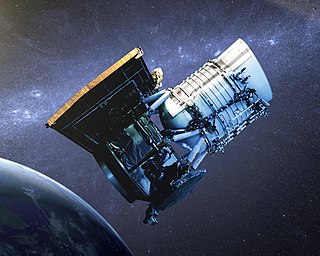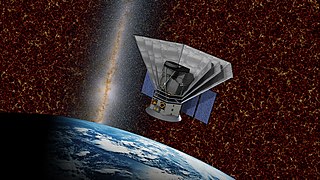Infrared astronomy is a sub-discipline of astronomy which specializes in the observation and analysis of astronomical objects using infrared (IR) radiation. The wavelength of infrared light ranges from 0.75 to 300 micrometers, and falls in between visible radiation, which ranges from 380 to 750 nanometers, and submillimeter waves.

The Wilkinson Microwave Anisotropy Probe (WMAP), originally known as the Microwave Anisotropy Probe, was a NASA spacecraft operating from 2001 to 2010 which measured temperature differences across the sky in the cosmic microwave background (CMB) – the radiant heat remaining from the Big Bang. Headed by Professor Charles L. Bennett of Johns Hopkins University, the mission was developed in a joint partnership between the NASA Goddard Space Flight Center and Princeton University. The WMAP spacecraft was launched on 30 June 2001 from Florida. The WMAP mission succeeded the COBE space mission and was the second medium-class (MIDEX) spacecraft in the NASA Explorer program. In 2003, MAP was renamed WMAP in honor of cosmologist David Todd Wilkinson (1935–2002), who had been a member of the mission's science team. After nine years of operations, WMAP was switched off in 2010, following the launch of the more advanced Planck spacecraft by European Space Agency (ESA) in 2009.

The James Webb Space Telescope (JWST) is a space telescope currently conducting infrared astronomy. As the largest telescope in space, it is equipped with high-resolution and high-sensitivity instruments, allowing it to view objects too old, distant, or faint for the Hubble Space Telescope. This enables investigations across many fields of astronomy and cosmology, such as observation of the first stars, the formation of the first galaxies, and detailed atmospheric characterization of potentially habitable exoplanets.

Galaxy Evolution Explorer was a NASA orbiting space telescope designed to observe the universe in ultraviolet wavelengths to measure the history of star formation in the universe. In addition to paving the way for future ultraviolet missions, the space telescope allowed astronomers to uncover mysteries about the early universe and how it evolved, as well as better characterize phenomena like black holes and dark matter. The mission was extended three times over a period of 10 years before it was decommissioned in June 2013. GALEX was launched on 28 April 2003 and decommissioned in June 2013.

Observational astronomy is a division of astronomy that is concerned with recording data about the observable universe, in contrast with theoretical astronomy, which is mainly concerned with calculating the measurable implications of physical models. It is the practice and study of observing celestial objects with the use of telescopes and other astronomical instruments.

NASA's series of Great Observatories satellites are four large, powerful space-based astronomical telescopes launched between 1990 and 2003. They were built with different technology to examine specific wavelength/energy regions of the electromagnetic spectrum: gamma rays, X-rays, visible and ultraviolet light, and infrared light.

The VLT Survey Telescope (VST) is a telescope located at ESO’s Paranal Observatory in the Atacama Desert of northern Chile. It is housed in an enclosure immediately adjacent to the four Very Large Telescope (VLT) Unit Telescopes on the summit of Cerro Paranal. The VST is a wide-field survey telescope with a field of view twice as broad as the full Moon. It is the largest telescope in the world designed to exclusively survey the sky in visible light.

Neil Gehrels Swift Observatory, previously called the Swift Gamma-Ray Burst Explorer, is a NASA three-telescope space observatory for studying gamma-ray bursts (GRBs) and monitoring the afterglow in X-ray, and UV/Visible light at the location of a burst. It was launched on 20 November 2004, aboard a Delta II launch vehicle. Headed by principal investigator Neil Gehrels until his death in February 2017, the mission was developed in a joint partnership between Goddard Space Flight Center (GSFC) and an international consortium from the United States, United Kingdom, and Italy. The mission is operated by Pennsylvania State University as part of NASA's Medium Explorer program (MIDEX).
The Beyond Einstein program is a NASA project designed to explore the limits of General theory of Relativity of Albert Einstein. The project includes two space observatories, and several observational cosmology probes. The program culminates with the Einstein Vision probes, after completion of the Great Observatories program.

Wide-field Infrared Survey Explorer is a NASA infrared astronomy space telescope in the Explorers Program. It was launched in December 2009, and placed in hibernation mode in February 2011, before being re-activated in 2013 and renamed the Near-Earth Object Wide-field Infrared Survey Explorer (NEOWISE). WISE discovered thousands of minor planets and numerous star clusters. Its observations also supported the discovery of the first Y-type brown dwarf and Earth trojan asteroid.

An infrared telescope is a telescope that uses infrared light to detect celestial bodies. Infrared light is one of several types of radiation present in the electromagnetic spectrum.

Cornelis A. "Neil" Gehrels was an American astrophysicist specializing in the field of gamma-ray astronomy. He was Chief of the Astroparticle Physics Laboratory at NASA's Goddard Space Flight Center (GSFC) from 1995 until his death, and was best known for his work developing the field from early balloon instruments to today's space observatories such as the NASA Swift mission, for which he was the Principal investigator. He was leading the WFIRST wide-field infrared telescope forward toward a launch in the mid-2020s. He was a member of the National Academy of Sciences and the American Academy of Arts and Sciences.

Euclid is a spacecraft carrying a wide-angle space telescope with a 600-megapixel camera to record visible light and a near-infrared spectrometer and photometer to determine the redshift of the detected galaxies. It was developed by the European Space Agency (ESA) and the Euclid Consortium and was launched on 1 July 2023. After approximately one month, it will reach its destination, a Lissajous orbit around the Lagrange point L2, at an average distance of 1.5 million kilometers beyond Earth’s orbit, where centrifugal and gravitational forces are such that objects move in tandem with the Earth around the Sun. The telescope is expected to remain operational for at least six years.

The Nancy Grace Roman Space Telescope is a NASA infrared space telescope in development and scheduled to launch by May 2027.

The International X-ray Observatory (IXO) is a cancelled X-ray telescope that was to be launched in 2021 as a joint effort by NASA, the European Space Agency (ESA), and the Japan Aerospace Exploration Agency (JAXA). In May 2008, ESA and NASA established a coordination group involving all three agencies, with the intent of exploring a joint mission merging the ongoing XEUS and Constellation-X Observatory (Con-X) projects. This proposed the start of a joint study for IXO. NASA was forced to cancel the observatory due to budget constrains in fiscal year 2012. ESA however decided to reboot the mission on its own developing Advanced Telescope for High Energy Astrophysics as a part of Cosmic Vision program.

The 2012 National Reconnaissance Office space telescope donation to NASA was the declassification and donation to NASA of two identical space telescopes by the United States National Reconnaissance Office. The donation has been described by scientists as a substantial improvement over NASA's current Hubble Space Telescope. Although the telescopes themselves were given to NASA at no cost, the space agency must still pay for the cost of instruments and electronics for the telescopes, as well as the satellites to house them and the launch of the telescopes. On February 17, 2016, the Nancy Grace Roman Space Telescope was formally designated as a mission by NASA, predicated on using one of the space telescopes.

Michael Logan Lampton was an American astronaut, founder of the optical ray tracing company Stellar Software, and known for his paper on electroacoustics with Susan M Lea, The theory of maximally flat loudspeaker systems.
The Space Variable Objects Monitor (SVOM) is a planned small X-ray telescope satellite under development by China National Space Administration (CNSA), Chinese Academy of Sciences (CAS) and the French Space Agency (CNES), to be launched in the spring of 2024.

SPHEREx is a future near-infrared space observatory that will perform an all-sky survey to measure the near-infrared spectra of approximately 450 million galaxies. In February 2019, SPHEREx was selected by NASA for its next Medium-Class Explorers mission, beating out two competing mission concepts: Arcus and FINESSE. As of August 2022, SPHEREx is targeted to launch no earlier than April 2025 on a Falcon 9 launch vehicle from Vandenberg Space Force Base. The principal investigator is James Bock at California Institute of Technology (Caltech) in Pasadena, California.
















